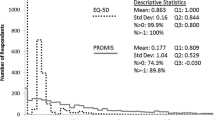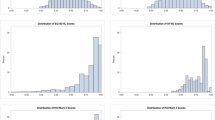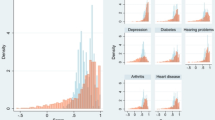Abstract
Background
Utility scores for use in cost-utility analysis may be imputed from the SF-36 health instrument using various techniques, typically regression analysis. This paper explored imputation using partial credit Rasch analysis.
Method
Data from the Assessment of Quality of Life (AQoL) instrument validation study were re-analysed (n = 996 inpatients, outpatients and a community sample). For each AQoL item, factor analysis identified those SF-36 items forming a unidimensional scale. Rasch analysis located scale logit scores for these SF-36 items. The logit scores were used to assign AQoL item scores. The standard AQoL scoring algorithm was then applied to obtain the utility scores.
Results
Many SF-36 items were limited predictors of AQoL items; some items from both instruments obtained disordered thresholds. All imputed scores were consistent with the AQoL model and fell within AQoL score boundaries. The explained variance between imputed and true AQoL scores was 61%.
Discussion
Rasch-imputed mapping, unlike many regression-based algorithms, produced results consistent with the axioms of utility measurement, while the proportion of explained variance was similar to regression-based modelling. Item properties on both instruments implied that some items should be revised using Rasch analysis. The methods and results may be used by researchers needing to impute utility scores from SF-36 health scores.



Similar content being viewed by others
Abbreviations
- AQoL:
-
Assessment of Quality of Life multi-attribute utility instrument
- CUA:
-
Cost-utility analysis
- DIF:
-
Differential item functioning
- EFA:
-
Exploratory factor analysis
- ICC:
-
Intra-class correlation
- MAU:
-
Multi-attribute utility
- QALY:
-
Quality-adjusted life year
- SF-36:
-
Short Form-36 health survey
References
Hawthorne, G., Richardson, J., & Day, N. A. (2001). A comparison of the Assessment of Quality of Life (AQoL) with four other generic utility instruments. Annals of Medicine, 33, 358–370. doi:10.3109/07853890109002090.
Ware, J. E., Snow, K. K., Kosinski, M., & Gandek, B. (1993). SF-36 health survey: manual and interpretation guide. Boston, MA: The Health Institute, New England Medical Center.
Franks, P., Lubetkin, E. I., Gold, M. R., & Tancredi, D. J. (2003). Mapping the SF-12 to preference-based instruments: convergent validity in a low-income, minority population. Medical Care, 41, 1277–1283. doi:10.1097/01.MLR.0000093480.58308.D8.
Franks, P., Lubetkin, E. I., Gold, M. R., Tancredi, D. J., & Jia, H. (2004). Mapping the SF-12 to the EuroQol EQ-5D Index in a national US sample. Medical Decision Making, 24, 247–254. doi:10.1177/0272989X04265477.
Fryback, D. G., Lawrence, W. F., Martin, P. A., Klein, R., & Klein, B. E. (1997). Predicting Quality of Well-being scores from the SF-36: results from the Beaver Dam Health Outcomes Study. Medical Decision Making, 17, 1–9. doi:10.1177/0272989X9701700101.
Mortimer, D., Segal, L., Hawthorne, G., & Harris, A. (2007). Item-based versus subscale-based mappings from the SF-36 to a preference-based quality of life measure. Value in Health, 10, 398–407. doi:10.1111/j.1524-4733.2007.00194.x.
Nichol, M. B., Sengupta, N., & Globe, D. R. (2001). Evaluating quality-adjusted life years: estimation of the health utility index (HUI2) from the SF-36. Medical Decision Making, 21, 105–112. doi:10.1177/02729890122062352.
Segal, L., Day, S. E., Chapman, A. B., & Osborne, R. H. (2004). Can we reduce disease burden from osteoarthritis? An evidence-based priority setting model. The Medical Journal of Australia, 180, S11–S17.
Brazier, J., Roberts, J., & Deverill, M. (2002). The estimation of a preference-based measure of health from the SF-36. Journal of Health Economics, 21, 271–292. doi:10.1016/S0167-6296(01)00130-8.
Brazier, J., Usherwood, T., Harper, R., & Thomas, K. (1998). Deriving a preference-based single index from the UK SF-36 Health Survey. Journal of Clinical Epidemiology, 51, 1115–1128. doi:10.1016/S0895-4356(98)00103-6.
Mortimer, D., & Segal, L. (2008). Comparing the incomparable? A systematic review of competing techniques for converting descriptive measures of health status into QALY-weights. Medical Decision Making, 28, 66–89. doi:10.1177/0272989X07309642.
Lundberg, L., Johannesson, M., Isacson, D. G., & Borgquist, L. (1999). The relationship between health-state utilities and the SF-12 in a general population. Medical Decision Making, 19, 128–140. doi:10.1177/0272989X9901900203.
Brazier, J. E., Kolotkin, R. L., Crosby, R. D., & Williams, G. R. (2004). Estimating a preference-based single index for the Impact of Weight on Quality of Life-Lite (IWQOL-Lite) instrument from the SF-6D. Value in Health, 7, 490–498. doi:10.1111/j.1524-4733.2004.74012.x.
Gray, A. M., Rivero-Arias, O., & Clarke, P. M. (2006). Estimating the association between SF-12 responses and EQ-5D utility values by response mapping. Medical Decision Making, 26, 18–29. doi:10.1177/0272989X05284108.
Thurstone, L. L. (1928). Attitudes can be measured. American Journal of Sociology, 33, 529–554. doi:10.1086/214483.
Wright, B. D. (1989). Rasch model from Thurstone’s scaling requirements. Rasch Measurement Transactions, 2, 13–14.
Andrich, D. (1985). An elaboration of Guttman scaling with Rasch models for measurement. In N. Brandon-Tuma (Ed.), Sociological methodology (pp. 33–80). San Francisco, CA: Jossey-Bass.
Coste, J., & Pouchot, J. (2003). A grey zone for quantitative diagnostic and screening tests. International Journal of Epidemiology, 32, 304–313. doi:10.1093/ije/dyg054.
Rasch, G. (1960). In B. Rasc (Ed.), Probabilistic models for some intelligence and attainment tests (p. 184). Copenhagen, Denmark: Danmarks Paedagogiske Institut.
Masters, G. N. (1982). A Rasch model for partial credit scoring. Psychometrika, 47, 149–174. doi:10.1007/BF02296272.
Hawthorne, G., Richardson, J., & Osborne, R. (1999). The Assessment of Quality of Life (AQoL) instrument: a psychometric measure of health-related quality of life. Quality of Life Research, 8, 209–224. doi:10.1023/A:1008815005736.
Andrich, D. (1978). A rating formulation for ordered response categories. Psychometrika, 43, 561–573. doi:10.1007/BF02293814.
Mokken, R. J., & Lewis, C. (1982). A nonparametric approach to the analysis of dichotomous item responses. Applied Psychological Measurement, 6, 417–430. doi:10.1177/014662168200600404.
Zhu, W. (1998). Test equating: what, why, how? Research Quarterly for Exercise and Sport, 69, 11–23.
Dobrez, D., Cella, D., Pickard, A. S., Lai, J. S., & Nickolov, A. (2007). Estimation of patient preference-based utility weights from the functional assessment of cancer therapy—general. Value in Health, 10, 266–272. doi:10.1111/j.1524-4733.2007.00181.x.
Brazier, J. E., & Roberts, J. (2004). The estimation of a preference-based measure of health from the SF-12. Medical Care, 42, 851–859. doi:10.1097/01.mlr.0000135827.18610.0d.
Raczek, A. E., Ware, J. E., Bjorner, J. B., Gandek, B., Haley, S. M., Aaronson, N. K., et al. (1998). Comparison of Rasch and summated rating scales constructed from SF-36 physical functioning items in seven countries: results from the IQOLA Project. International Quality of Life Assessment. Journal of Clinical Epidemiology, 51, 1203–1214. doi:10.1016/S0895-4356(98)00112-7.
Pickard, A. S., Kohlmann, T., Janssen, M. F., Bonsel, G., Rosenbloom, S., & Cella, D. (2007). Evaluating equivalency between response systems: application of the Rasch model to a 3-level and 5-level EQ-5D. Medical Care, 45, 812–819. doi:10.1097/MLR.0b013e31805371aa.
Hawthorne, G., & Richardson, J. (2001). Measuring the value of program outcomes: a review of multiattribute utility measures. Expert Review of Pharmacoeconomics and Outcomes Research, 1, 215–228.
Chan, K.-Y., Drasgow, F., & Sawin, L. L. (1999). What is the shelf life of a test? The effect of time on the psychometrics of a cognitive ability test battery. The Journal of Applied Psychology, 84, 610–619. doi:10.1037/0021-9010.84.4.610.
Edelen, M. O., & Reeve, B. B. (2007). Applying item response theory (IRT) modeling to questionnaire development, evaluation, and refinement. Quality of Life Research, 16(Suppl 1), 5–18. doi:10.1007/s11136-007-9198-0.
Rummel, R. J. (1970). Applied factor analysis (pp. 24–27). Evanston, IL: Northwestern University Press.
Conway, J. M., & Huffcutt, A. I. (2003). A review and evaluation of exploratory factor analysis practices in organizational research. Organizational Research Methods, 6, 147–168. doi:10.1177/1094428103251541.
Ford, J. K., MacCallum, R. C., & Tait, M. (1986). The application of exploratory factor analysis in applied psychology: a critical review and analysis. Personnel Psychology, 39, 291–314. doi:10.1111/j.1744-6570.1986.tb00583.x.
Tabachnick, B. G., & Fidell, L. S. (2001). Using multivariate statistics (4th ed., p. 966). New York: Harper Collins.
Reise, S. P., Waller, N. G., & Comrey, A. L. (2000). Factor analysis and scale revision. Psychological Assessment, 12, 287–297. doi:10.1037/1040-3590.12.3.287.
Hair, J. F., Anderson, R. E., Tatham, R. L., & Black, W. C. (1998). Multivariate data analysis (5th ed.). Upper Saddle River, NJ: Prentice Hall.
Stone, M., & Yumoto, F. (2004). The effect of sample size for estimating Rasch/IRT parameters with dichotomous items. Journal of Applied Measurement, 5, 48–61.
Linacre, J. M. (1994). Sample size and item calibration stability. Rasch Measurement Transactions, 7, 328–331.
Pallant, J. F., & Tennant, A. (2007). An introduction to the Rasch measurement model: an example using the Hospital Anxiety and Depression Scale (HADS). The British Journal of Clinical Psychology, 46, 1–18. doi:10.1348/014466506X96931.
Hambleton, R. K., Jones, R. W., & Rogers, H. J. (1993). Influence of item parameter estimation errors in test development. Journal of Educational Measurement, 30, 143–155. doi:10.1111/j.1745-3984.1993.tb01071.x.
SPSS Inc. (2004). SPSS for Windows, version 13.0. Chicago, IL: SPSS Inc.
Andrich, D., Sheridan, B., & Luo, G. (2005). RUMM2020. Perth, Australia: RUMM Laboratory Pty Ltd.
Hambleton, R. K., Swaminathan, H., & Rogers, H. J. (1991). Fundamentals of item response theory. Newbury Park: Sage Publications.
Dorans, N. J. (2007). Linking scores from multiple health outcome instruments. Quality of Life Research, 16(Suppl 1), 85–94. doi:10.1007/s11136-006-9155-3.
Teresi, J. A. (2006). Overview of quantitative measurement methods. Equivalence, invariance, and differential item functioning in health applications. Medical Care, 44, S39–S49. doi:10.1097/01.mlr.0000245452.48613.45.
Reise, S. P., Morizot, J., & Hays, R. D. (2007). The role of the bifactor model in resolving dimensionality issues in health outcomes measures. Quality of Life Research, 16(Suppl 1), 19–31. doi:10.1007/s11136-007-9183-7.
Acknowledgements
The research reported in this paper was supported by an Australian National Health and Medical Research Council (NHMRC) Project Grant, the Department of Psychiatry in the Faculty of Medicine, Dentistry and Health Sciences at The University of Melbourne and the Centre for Health Economics at Monash University. Much of this work was completed while Professor Leonie Segal was working at the Centre for Health Economics at Monash University prior to taking up her current position as the Professor of Health Economics, Division of Health Sciences, University of South Australia. The views expressed herein are the sole responsibility of the authors. The authors have no competing interests to declare.
Author information
Authors and Affiliations
Corresponding author
Rights and permissions
About this article
Cite this article
Hawthorne, G., Densley, K., Pallant, J.F. et al. Deriving utility scores from the SF-36 health instrument using Rasch analysis. Qual Life Res 17, 1183–1193 (2008). https://doi.org/10.1007/s11136-008-9395-5
Received:
Accepted:
Published:
Issue Date:
DOI: https://doi.org/10.1007/s11136-008-9395-5




